Understanding the Three-Card Tarot Reading
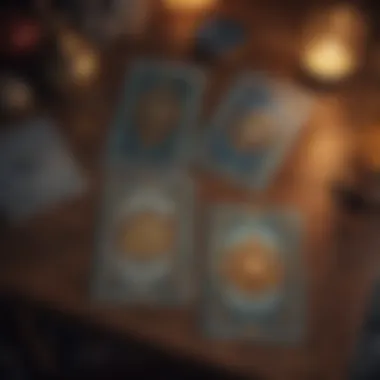
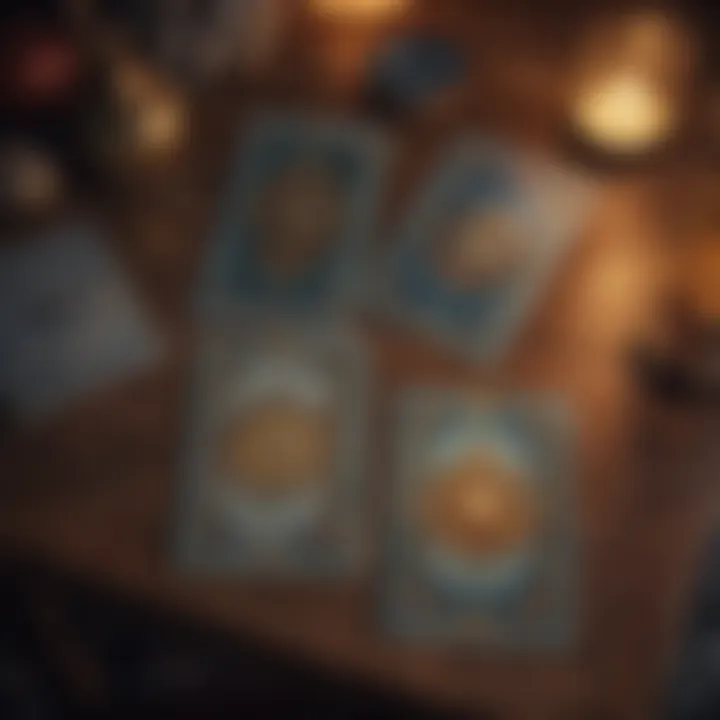
Intro
The realm of tarot reading often evokes curiosity and intrigue, a practice deeply rooted in history and psychology. A three-card tarot reading is a fundamental concept that many practitioners use to gain clarity and insight. It offers a straightforward yet profound way to explore personal questions, uncover hidden aspects of one's life, and engage in self-reflection. Understanding this technique can enhance one’s connection to intuition and foster personal growth.
As we delve into this topic, we will examine the structure of the three-card spread, the meanings behind the cards, and its practical applications in daily life. The expansive nature of tarot extends beyond mere card interpretation; it invites profound self-exploration and decision-making guidance. Through this examination, readers can expect to gain a thorough understanding of how to effectively implement the three-card reading in both their personal and professional lives.
Structure of the Three-Card Reading
The three-card tarot reading typically consists of three distinct positions, each representing different aspects or phases of a situation. The common layout involves:
- Past: This card reflects influences or events from the past that continue to affect the current situation. It helps in understanding the origins of present difficulties or successes.
- Present: This card represents the current state of affairs. It provides insight into what is happening now and the immediate challenges or advantages one may face.
- Future: This card suggests potential outcomes based on the current trajectory. It allows for reflection on what actions may be necessary to steer towards a desirable conclusion.
The simplicity of this structure makes it accessible for both novices and experienced readers. Each card, depending on its placement, contributes significantly to the overarching narrative revealed during the reading.
Understanding Card Meanings
Interpreting the cards involved in a three-card reading requires a deep understanding of their symbolism. Each card holds specific meanings that can shift based on context and placement. Some common interpretations include:
- Major Arcana: These cards often represent significant life events or themes. For instance, The Fool signifies new beginnings and adventures, while The Tower indicates upheaval and transformation.
- Minor Arcana: These cards deal with day-to-day situations. Their numerical significance and suit (Wands, Cups, Swords, Pentacles) add depth to their interpretation. For example, a Three of Cups may signify celebration and community, while a Five of Swords hints at conflict and tension.
The interplay between cards can shift interpretations as well. A reading's meaning transforms when cards are drawn in specific sequences or when they appear together, creating a narrative that is unique to each session.
Practical Applications
The insights gained from a three-card tarot reading can significantly enhance decision-making processes and promote introspection. Here are several practical applications:
- Personal Growth: Engaging with tarot in this way fosters self-reflection. It encourages an exploration of inner thoughts and feelings that may otherwise remain hidden.
- Decision Making: When faced with choices, a three-card reading can provide guidance by highlighting the potential outcomes and influences of different paths.
- Relationships: This technique can also be useful in understanding dynamics in personal and professional relationships, providing clarity on emotions and underlying issues.
Preface to Tarot
Tarot serves as a profound instrument for self-discovery and insight, making it critical to our exploration of the three-card reading methodology. Understanding tarot lays the foundation for anyone wishing to delve deeper into its meanings and utility. This introduction equips readers with essential knowledge about tarot's nature, guiding their interpretation and application.
What is Tarot?
Tarot is a deck of cards traditionally used for divination and introspection. It consists of 78 cards divided into two main sections: the Major Arcana and the Minor Arcana. The Major Arcana includes 22 cards that symbolize significant life events and spiritual lessons, while the 56 cards of the Minor Arcana focus on day-to-day life and immediate challenges. The imagery and symbolism on these cards can provide insights and reflections that help one navigate life's complexities.
The three-card spread represents a focused approach to tarot readings, making it accessible for beginners while still offering depth for experienced practitioners. Each card selected conveys important messages influenced by its position, allowing for a nuanced interpretation of personal circumstances.
Brief History of Tarot
The origins of tarot trace back to the 15th century in Europe, primarily as a playing card game known as tarocchi. Its evolution into a tool for divination began in the 18th century when mystics and occultists began attributing symbolic meanings to the cards. This transition has created a rich tapestry of interpretations influenced by cultural, psychological, and spiritual dimensions.
The earliest tarot decks, such as the Visconti-Sforza deck, were hand-painted and reflected the aesthetics and values of their time. Over centuries, various decks emerged, instilling diverse themes and imagery. In the modern context, tarot cards have become integral in new age practices and personal development, appealing particularly to those interested in holistic life approaches and astrology.
"Tarot connects us to our intuition and can guide our choices."
Today, tarot is embraced in various formats, from traditional readings to modern digital apps, allowing accessibility across a wide demographic. This rich history sets the stage for understanding its practical uses, especially through formats like the three-card reading, which distills complex meanings into an effective, manageable format.
The Structure of the Three-Card Reading
The structure of the three-card reading is foundational in tarot practice. A clear understanding of this structure not only aids in accurate interpretations but also enhances the overall experience of the reader and the seeker. Each reading provides insights into different aspects of life, making it a versatile tool for exploration.
Layout and Positioning of Cards
The layout of the cards in a three-card reading is straightforward yet intentional. Typically, three cards are laid out in a row, each representing a distinct aspect of the inquiry. The positioning signifies the progression of understanding through the reading.
- Past: The first card usually symbolizes influences from the past. This could be events or emotions that have shaped the current situation. Understanding this context is critical for interpreting how past experiences affect present circumstances.
- Present: The second card reflects the current situation. It should provide clarity on where the seeker stands, revealing challenges or opportunities that are currently at play.
- Future: The final card looks towards possible outcomes or future influences. This aspect can guide the seeker towards potential decisions and actions.
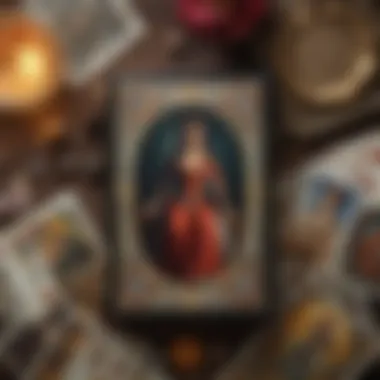
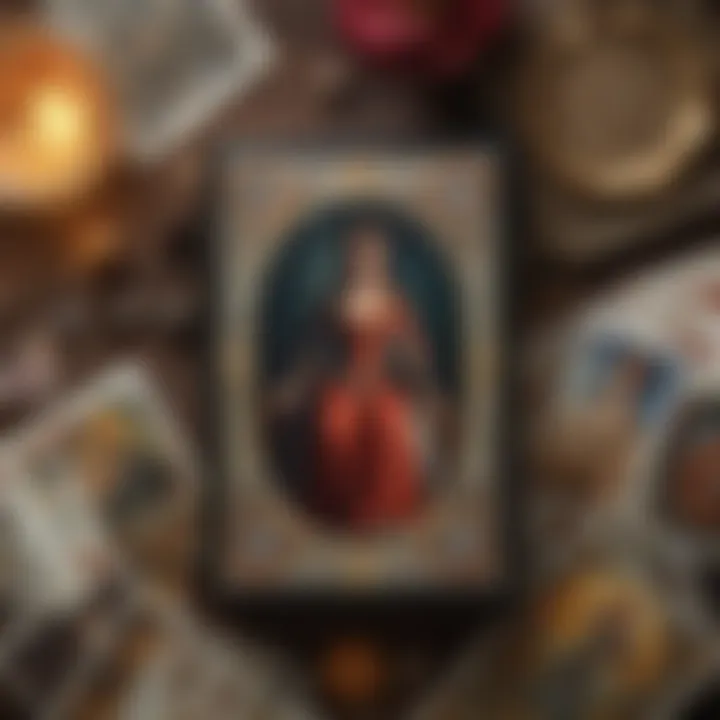
Carefully observing the layout helps in building a cohesive narrative during the reading. Each card does not exist in isolation; rather, it interacts with its neighbors, enriching the interpretation.
Significance of Each Card Position
The significance of each card position cannot be understated. Each position provides context, influencing the reading's overall message.
- Understanding the Past: Reflecting on past events allows the reader to gain insights into recurring themes. For instance, if the card reveals feelings of loss, it may indicate a pattern of attachment or fear regarding change.
- Interpreting the Present: This card acts as a snapshot, offering clarity and guidance on immediate challenges. It sets the stage for understanding what needs addressing now.
- Predicting the Future: The future card is often viewed with a mix of hope and caution. It may not be deterministic but suggests possible outcomes based on current energies. This highlights the importance of personal choice and agency in shaping one's path.
Understanding these positions fosters deeper reflection. It encourages the practitioner to explore how past emotions shape current realities and future possibilities.
"The three-card spread is popular due to its simplicity and depth, making it accessible for both beginners and experienced readers."
Engagement with the structure and positions of the cards allows for a structured approach to introspection. Through this framework, seekers can glean profound knowledge about their life journey.
Card Interpretations
Card interpretations play a crucial role in the effectiveness of the three-card tarot reading. Understanding how to interpret each card allows the reader to derive deeper meanings and insights. Interpretation entails not only recognizing the card's individual symbolism but also grasping its context within the layout. This dynamic interaction between the cards provides layers of information, aiding personal reflection and decision-making.
In three-card readings, the emphasis on card interpretations can reveal significant aspects of a person's life, including challenges, opportunities, and potential pathways forward. Each card acts as a mirror, reflecting the querent’s current situation while also prompting thoughtful consideration of their past and future. By engaging actively with the cards, practitioners can uncover hidden beliefs and motivations that may influence their choices.
Major Arcana in Three-Card Readings
The Major Arcana consists of 22 cards, each representing profound life lessons and archetypal themes. In a three-card layout, when one or more Major Arcana cards appear, they often point to significant life changes or pivotal moments. Their presence suggests that the situation at hand is influenced by deep psychological truths and broader spiritual lessons.
For example, the Fool card may signify new beginnings, encouraging a leap into the unknown. The Tower, on the other hand, could indicate upheaval or a necessary shift in mindset. Recognizing these symbolic meanings helps to frame the querent's experience in a more holistic way. Therefore, understanding how to interpret these cards effectively can enrich the reading and provide invaluable insights.
Some key considerations in interpreting Major Arcana cards:
- Core Message: Identify the essential theme that the card embodies.
- Personal Relevance: Consider how this theme applies to the querent’s situation.
- Interconnectivity: Analyze how it interacts with the other cards in the spread.
Minor Arcana in Three-Card Readings
The Minor Arcana is composed of four suits: Wands, Cups, Swords, and Pentacles, each corresponding to different life aspects such as creativity, emotions, intellect, and material matters. In three-card readings, these cards provide detailed narratives about the querent's day-to-day experiences and emotional landscape.
Interpreting the Minor Arcana requires a nuanced understanding of the suit meanings and their associated numerical values. For example, while the Three of Wands may signify foresight and exploration in career ventures, the Five of Cups often highlights feelings of loss or disappointment.
In a three-card spread, the Minor Arcana can offer sharp insights into immediate concerns. Thus, their meanings can dynamically interact with the Major Arcana cards, creating a more intricate and holistic picture of the querent's life.
Here are some tips for interpreting Minor Arcana cards effectively:
- Focus on Context: Look at the position and relationship of the card to others.
- Apply Suit Meanings: Understand what each suit represents in the context of the reading.
- Reflect on Numerology: Consider the significance of the card's number, as it can give additional depth to the interpretation.
The art of interpretation in tarot demands both intuition and an analytical approach. Each card tells a part of the querent’s story, and together they weave a complex narrative that can guide personal exploration.
Engaging with Major and Minor Arcana cards not only fosters a deeper understanding of tarot as a tool but also enhances the reader's ability to guide others with compassion and insight.
Applications of the Three-Card Reading
The applications of the three-card reading are pivotal in understanding its role as a tool for personal growth and decision-making. This section will explore how the three-card spread can be utilized in various aspects of life, revealing its benefits and considerations. By examining personal insight, decision-making processes, and relationship dynamics, we can appreciate the diverse utility of this tarot practice.
Personal Insight and Reflection
The three-card reading is particularly effective in fostering personal insight and reflection. Each card can be viewed as a doorway into the self, revealing hidden emotions, motivations, and desires. When a person engages with tarot in this manner, they unlock a deeper understanding of their life circumstances. For example, the first card may represent current feelings or a situation, while the second card indicates obstacles or fears that may be present, and the third card reveals potential outcomes or paths forward.
Benefits of Personal Reflection:
- Enhanced Self-Awareness: Through consistent practice, individuals can better recognize their patterns and habits.
- Emotional Clarity: The cards provide clarity, helping to articulate feelings that might be difficult to express.
- Empowerment: Understanding one’s own story equips individuals to make informed choices moving forward.
When interpreting the cards in this context, it is crucial to resist the urge to search for definitive answers. Instead, the reading should stimulate contemplation and insight, allowing for personal growth on an individual level.
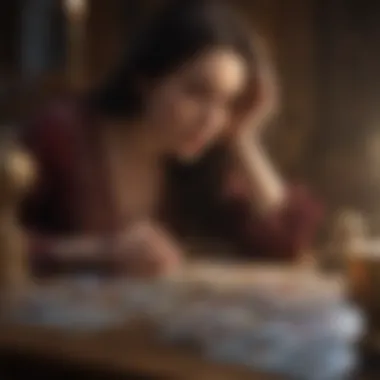
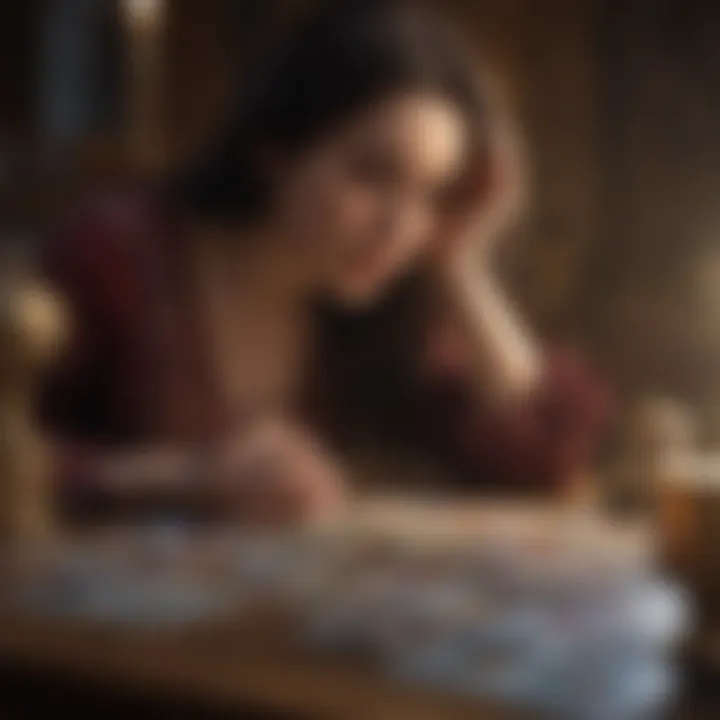
Decision-Making Process
Utilizing the three-card layout can significantly influence decision-making processes. In moments of uncertainty, a reading can guide individuals toward choices that align more closely with their true selves. Each card represents unique facets of the decision at hand. The first card often represents the present situation, the second offers insights into available options, and the third suggests probable outcomes based on the choices made.
Key Considerations:
- Clarity in Options: The cards can help clarify various alternatives, allowing for a more structured approach to decisions.
- Intuitive Guidance: Many find that the insights from the cards resonate with their intuition, leading to enlightened choices.
- Risk Assessment: The spread helps in evaluating potential risks associated with each option, transforming fear into informed decision-making.
By integrating a three-card reading into the decision-making process, individuals can approach choices from a place of awareness rather than confusion, resulting in a more confident navigation through life's complexities.
Relationship Dynamics
Tarot can also play a crucial role in understanding and navigating relationship dynamics. The three-card reading can provide insight into both romantic and platonic relationships. Each card can elucidate distinct attributes, challenges, or trajectories in relational contexts.
When applied to relationships, the first card could highlight an individual’s perspective or emotional state, the second may reveal the partner's viewpoint, and the third often culminates in the potential future of the relationship.
Implications for Relationships:
- Improved Communication: Insights can serve as a springboard for deeper conversations between partners.
- Conflict Resolution: By identifying underlying issues, the reading can assist in resolving conflicts and misunderstandings.
- Harmonizing Energies: Understanding the dynamics allows for a more empathetic approach to relationships, fostering connection and unity.
Common Practices in Three-Card Readings
Practicing a three-card tarot reading effectively requires an understanding of several key elements. This section addresses common practices that enhance the reading experience. Whether you are just starting or you have experience, adhering to these practices can provide clarity and aid in personal growth.
Choosing the Right Tarot Deck
Selecting a suitable tarot deck is crucial for effective readings. Each deck reflects the artist's interpretation and can resonate differently with individual users. Here are a few things to consider when making your choice:
- Personal Connection: Opt for a deck that visually speaks to you. Look for images and symbols that resonate on a personal level. The more connected you feel, the more intuitive your readings will be.
- Traditional vs. Modern: Some may prefer classic decks like the Rider-Waite or Thoth for their widespread interpretations. Others might lean towards modern or themed decks that align more with their personal beliefs.
- Card Size and Quality: Consider the size of the cards and the quality of the card stock. A comfortable deck facilitates easy shuffling and handling during readings.
Ultimately, the right deck is one that feels comfortable and enhances your intuitive practices in tarot reading.
Preparing for a Reading
Preparation is key in tarot practice. Establishing a mindful atmosphere can significantly influence the clarity of your readings. Here are essential steps to take:
- Create a Sacred Space: Find a quiet space where you feel at ease. Use candles or incense to create a calming atmosphere.
- Set an Intention: Before drawing cards, think about what you wish to explore. Write down your questions or intentions to focus your energy.
- Grounding Techniques: Take a moment to center yourself. Deep breathing or meditation can clear distractions and enhance your receptivity to the cards.
Following these preparation steps allows you to approach the reading with intention and presence, which are essential for a meaningful experience.
Recording the Reading
Keeping a record of your tarot readings holds immense value. It not only captures insights gained but also helps to track your progress over time. Here are some practical tips for effective recording:
- Journaling: Maintain a tarot journal. Note down the cards drawn, your interpretations, and any intuitive feelings or thoughts that arise during the reading. This becomes a valuable reference point for future readings.
- Reviewing Patterns: Regularly revisit past entries. Look for patterns or recurring themes in your readings. Understanding these can reveal deeper insights into your situation.
- Reflect on Outcomes: After time has passed, assess the accuracy of your predictions or insights. This reflection can help refine your interpretation skills and deepen your understanding of tarot.
Challenges and Misconceptions
Understanding Tarot, especially through the lens of three-card readings, involves navigating several challenges and misconceptions. These elements often shape people's perceptions and experiences with the practice. Recognizing these misunderstandings helps in fostering a clearer appreciation of Tarot's potential as a tool for insight.
Common Misinterpretations of Tarot
Many individuals approach Tarot with preconceived notions that can lead to significant misinterpretations. One of the primary misunderstandings centers around the idea that Tarot is purely about predicting the future. While Tarot can certainly offer insights into potential outcomes, its real power lies in self-reflection and personal growth. Each card holds a mirror to the subconscious, encouraging exploration of current situations rather then merely forecasting what is to come.
Another common misinterpretation is that Tarot readings are definitive and immutable. This perspective fails to acknowledge the fluidity of life and the concept of free will. The cards provide guidance based on current energies and circumstances, but the interpretation is subjective. Hence, the outcome may vary based on choices made after the reading. Tarot practitioners should emphasize that readings are not set in stone but rather advisory.
"Tarot acts as a request for introspection; it opens a dialogue with the self."
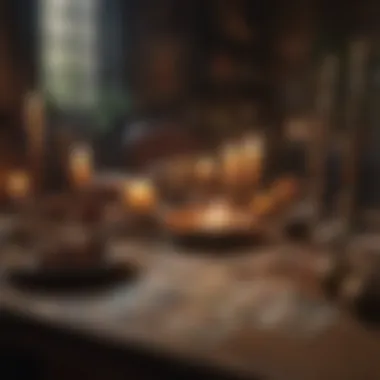
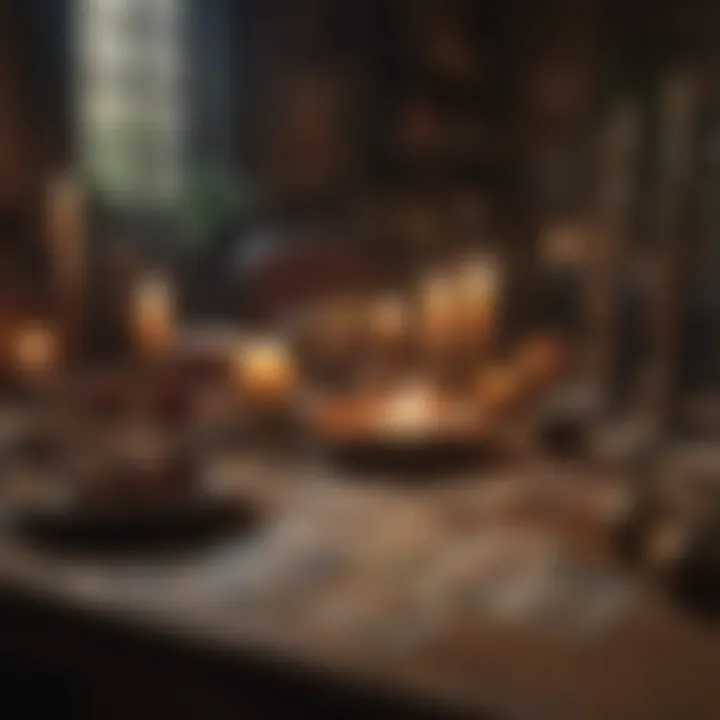
Additionally, some believe Tarot requires a special gift or innate skill. In truth, this practice is accessible to anyone willing to learn. Familiarity with the card meanings and the intuitive process can be developed. Enthusiasts often find joy in engaging with the cards, which promotes a deeper understanding of their meanings.
Addressing Skepticism
Skepticism about Tarot can stem from various sources, including cultural beliefs, personal experiences, or exposure to negative representations in media. Addressing this skepticism is crucial for the advancement of Tarot as both an art and a science.
One effective approach for overcoming skepticism is through education. Providing well-researched information about the history and philosophy of Tarot can dispel myths. For example, Tarot has origins in medieval Europe and was initially used for more than divination. Its history can demonstrate its complexity and richness, positioning it as a legitimate tool for contemplation rather than mere fortune-telling.
Encouraging open dialogue is also important. Allowing skeptics to voice their concerns and questions can lead to constructive conversations. Engaging in discussions that highlight personal experiences with Tarot allows skeptics to see its practical benefits in real-life contexts.
In summary, overcoming misconceptions and skepticism in Tarot reading requires patience and a willingness to educate others. With every discussion, there comes the potential to transform doubt into understanding.
By acknowledging these challenges, practitioners can strengthen their practice, inviting a more profound appreciation of Tarot's transformative abilities.
Psychological Aspects of Tarot
The psychological dimensions of tarot readings are crucial to understanding how individuals interact with this form of divination. Tarot goes beyond mere fortune-telling, allowing practitioners to explore their inner selves, motivations, and personal narratives. By engaging with tarot cards, people navigate their thoughts, emotions, and life situations, often revealing insights that might otherwise remain unexamined. The psychological interplay can lead to profound personal growth and clarity.
The Role of Intuition
Intuition plays a vital part in tarot readings. Practitioners often rely on their instincts to interpret the meanings behind the cards. This is not just a random exercise but a process that taps into subconscious knowledge. When someone engages with the cards, they might find their feelings and thoughts emerging naturally. This connection to intuition enables deeper exploration of personal issues, leading to revelations that can guide future choices.
During a three-card reading, the position of each card provides context. The first card often relates to the past, the second to the present, and the third to the future. Here, intuition helps the reader understand the narrative the cards are unfolding. Each card presents not just symbols but emotional cues that resonate with the reader. This interaction fosters a unique dialogue between the individual and the cards.
The Influence of Archetypes
Archetypes are fundamental frameworks that help individuals comprehend their life experiences. In the context of tarot, these archetypal images, often drawn from the Major Arcana, resonate universally. For instance, The Fool represents new beginnings and spontaneity. The Empress embodies fertility and abundance. Engaging with these archetypes enables people to see their own stories mirrored in the cards.
The influence of archetypes offers a structured way to process emotions and experiences. Each card can trigger reflections on personal circumstances, facilitating deeper understanding. Practitioners might identify with different archetypes at various life stages. This makes tarot not just a means of divination but also a tool for psychological exploration and growth.
"Tarot taps into collective unconsciousness, offering pathways to self-discovery and personal development."
Future of Tarot Practices
The future of tarot practices presents an intriguing landscape for both seasoned practitioners and curious newcomers. As modernity influences traditional practices, the evolution of tarot interpretations plays a crucial role in maintaining the relevance of this ancient system of divination. This section aims to explore what that future may hold, examining the integration of tarot within contemporary spirituality, and how these developments can provide a richer, more intuitive experience for users.
Evolution of Tarot Interpretations
The interpretations of tarot are not static; they evolve based on cultural, spiritual, and psychological shifts over time. As society changes, so too does the language of tarot. The symbols and messages conveyed through the cards adapt to resonate with current collective themes and individual needs.
- Cultural Resilience: Tarot has shown a remarkable ability to remain relevant, adapting its symbols to fit various cultural contexts. This adaptability means that practitioners can find contemporary meanings in traditional symbols, which enhances personal connection.
- Diverse Perspectives: The inclusive nature of modern spirituality allows tarot to be viewed through various lenses, including feminism, environmentalism, and psychological frameworks. This diversification enriches the interpretations of tarot cards, allowing for broader applications in one’s life.
- Digital Influence: With the rise of social media and digital platforms, tarot readings have found a new home online. This shift not only provides access to a wider audience but also allows interpretative styles to share and evolve in real-time.
Building a dialogue around tarot interpretations can further facilitate understanding and expansion of meanings. Future practitioners may find empowerment in redefining interpretations that resonate with their unique experiences.
Integration with Modern Spirituality
The integration of tarot into modern spiritual practices is both an opportunity and a necessity. As people seek holistic approaches to personal growth, they often incorporate tarot as a tool for deeper self-understanding.
- Holistic Practices: Tarot is increasingly seen as complementary to other spiritual modalities, such as meditation, yoga, and mindfulness. This trend emphasizes the interconnectedness of various practices, enriching the overall experience for users.
- Mental Health Awareness: As mental health gains positive recognition, tarot is recognized for its potential benefits in enhancing one’s psychological state. Card readings can serve as reflective practices that promote self-awareness and encourage introspection.
- Community Engagement: Online platforms have enabled a community atmosphere among tarot enthusiasts. By engaging in group readings or discussions about interpretations, practitioners can share insights that deepen their understanding and application of the cards.
"The synthesis of tarot with modern spirituality can provide seekers with a multi-dimensional approach to self-discovery and growth."
Ending
The conclusion of this article holds significant importance. It serves as a summation of key insights into the three-card tarot reading, ensuring that the reader leaves with a well-rounded understanding of the topic. This section reinforces the idea that tarot is not merely about predicting the future but rather a powerful tool for exploring one's internal landscape.
Embracing Tarot as a Tool for Insight
One of the primary benefits of using tarot, particularly in the context of a three-card reading, is the ability to foster personal insight. Each card drawn serves as a focal point for contemplation and reflection. By examining the cards in relation to the situation at hand, individuals can uncover layers of meaning that they might not have considered previously.
The three-card spread can be particularly effective because it allows for a simple yet profound exploration of past, present, and future influences. It offers clarity and direction, helping individuals navigate their choices and understand their emotional responses. As practitioners engage deeply with the images and symbolism in each card, they cultivate a more intuitive relationship with their inner thoughts and feelings.
Furthermore, tarot can act as a mirror, reflecting aspects of life that need attention. This reflective quality can lead to transformative insights that encourage personal growth and self-awareness. As individuals embrace tarot practices, they also align themselves with a broader spiritual or philosophical journey, enhancing the depth of their understanding.
In summary, embracing tarot as a tool for insight means recognizing its potential for unlocking personal revelations and fostering a deeper sense of self. The simplicity of the three-card reading belies its profound capability to engage profound introspection and thoughtful decision-making, ultimately helping individuals move toward a more fulfilled and conscious life.



